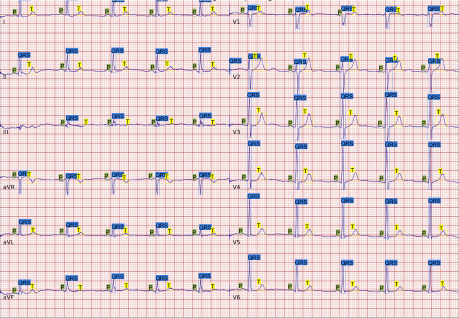Cardiology
Your Partner in Cardiology Data Labeling and Analysis
We understand that accurate data labeling is critical for the success of your cardiology research and to develop AI models. That's why we use advanced data labeling tools and expert human annotators to ensure the highest levels of accuracy and quality in our data labeling services. Our team of experienced data annotators and cardiology experts have a deep understanding of the unique challenges and complexities of cardiology data. We work closely with our clients to understand their specific needs and requirements, and tailor our services accordingly.

Empowering Accurate Cardiovascular AI With Expert Labeled Datasets
Accurately labeled cardiology datasets are critical for developing an AI model that can provide accurate diagnosis and treatment recommendations in the cardiology field. AI models in cardiology rely on vast amounts of labeled data to learn and recognize patterns that are indicative of specific cardiac conditions. Without accurate labeling, the AI model may learn incorrect patterns or make incorrect predictions, potentially leading to incorrect diagnoses or treatment recommendations. Moreover, the quality of the labeled dataset can impact the overall performance of the AI model. If the dataset is not labeled accurately or does not represent the diversity of cardiac conditions that may be encountered in clinical practice, the AI model may not perform optimally. This can limit its ability to detect rare or complex cardiac conditions or provide accurate recommendations for patient care. To ensure the accuracy and reliability of cardiology datasets, our expert annotators meticulously label various aspects of cardiovascular data. They carefully annotate ECG waveforms, cardiac imaging structures, and cardiac events, providing precise information for the development and training of AI models. By leveraging their domain expertise, our annotators contribute to the creation of robust labeled datasets that encompass a wide range of cardiac conditions, ensuring the AI models can learn and recognize diverse patterns. This empowers the AI models to make accurate predictions and recommendations, supporting healthcare professionals in making informed decisions for their patients.

ECG (Electrocardiogram) Labeling
Our expert annotators carefully analyze ECG recordings to detect various cardiac conditions such as arrhythmia, heart block, and ischemia. Through meticulous examination of the ECG waveforms, they identify and annotate specific abnormalities such as irregular heart rhythms, ST-segment elevation or depression, and P-QRS-T wave abnormalities. By accurately labeling these findings, we provide healthcare professionals with comprehensive insights into a patient's cardiac health, aiding in the diagnosis, monitoring, and treatment of cardiovascular conditions.
Holter Monitor Labeling
Holter monitors record continuous ECG signals over an extended period, typically 24-48 hours, capturing a wealth of cardiac data. Our skilled annotators carefully review and annotate these recordings to identify various cardiac events. They label and categorize events such as premature ventricular contractions (PVCs), atrial fibrillation (AFib), ventricular tachycardia (VT), and pauses in the cardiac rhythm. Accurate labeling of these events enables healthcare professionals to assess the frequency, duration, and severity of cardiac abnormalities, facilitating precise diagnosis and treatment planning.
Echocardiography Labeling
Echocardiography is a non-invasive imaging technique that uses ultrasound to visualize the structures and function of the heart. Our experienced annotators specialize in segmenting and labeling the various structures within echocardiography images. They annotate the chambers (such as the left and right ventricles and atria), valves (such as the mitral and aortic valves), and vessels (such as the aorta and pulmonary artery). Accurate annotation of these structures provides essential information for assessing cardiac anatomy, function, and potential abnormalities, supporting accurate diagnosis and treatment decisions.
Cardiac MRI Labeling
Cardiac MRI produces highly detailed images of the heart using magnetic fields and radio waves. Our annotators have expertise in segmenting and labeling the different components of cardiac MRI images. They accurately annotate the myocardium, identifying regions of ischemia or fibrosis, as well as the chambers (ventricles and atria) and major vessels (such as the aorta and pulmonary artery). Accurate labeling of these structures allows for precise assessment of cardiac morphology, function, and tissue characteristics, aiding in the diagnosis and management of various cardiac conditions.
Cardiac CT Labeling
Cardiac CT imaging provides detailed visualization of the heart and coronary arteries using X-rays. Our skilled annotators meticulously segment and label the coronary arteries, identifying stenoses, calcifications, or other abnormalities. They also annotate the chambers (ventricles and atria), valves (such as the aortic and mitral valves), and other cardiac structures. Accurate labeling of these structures allows for the assessment of coronary artery disease, cardiac morphology, and potential abnormalities, contributing to accurate diagnosis and treatment planning.
Wearable Sensor Labeling
With the increasing popularity of wearable devices, our annotators specialize in labeling data collected from wearable sensors such as smartwatches and fitness trackers. They accurately annotate heart rate measurements, identifying resting heart rate, exercise-induced heart rate, and heart rate variability. Additionally, they annotate activity levels, distinguishing between different intensity levels of physical activity. Precise labeling of wearable sensor data enables healthcare professionals and individuals to monitor cardiovascular health, track physical activity levels, and make informed decisions for better overall well-being.
Get The Best Cardiology Data Labeling Services
Frequently Asked Questions
1.
Why is data labeling important in cardiology?
Data labeling is important in cardiology as it enables accurate interpretation and analysis of cardiac data, such as electrocardiograms (ECGs) or cardiac imaging, facilitating precise diagnoses and treatment decisions.
2.
How is cardiology data labeling done?
Cardiology data labeling is done by trained annotators who review the data and apply labels to indicate specific cardiac features, abnormalities, or events of interest.
3.
What types of data are labeled in cardiology?
Types of data labeled in cardiology include electrocardiograms (ECGs), echocardiograms, cardiac MRI or CT images, Holter monitor recordings, and cardiac event monitors.
4.
Who performs cardiology data labeling?
With the help of skilled medical practitioners, trained annotators who possess specific knowledge of cardiac conditions perform the labeling. These annotators are well-versed in the intricacies of cardiology and are equipped with the expertise to accurately annotate cardiac data.
